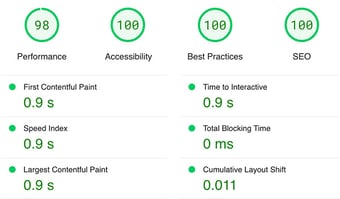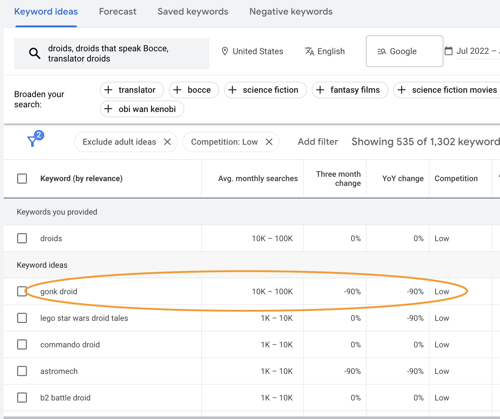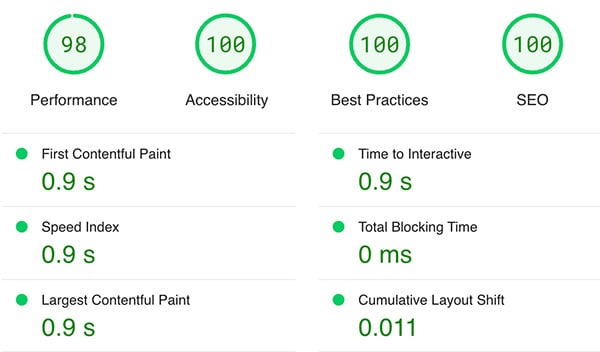INBOUND 2022: How to Futureproof Your Flywheel
Want to stay ahead of the game in the evolving marketing landscape? You’re in the right place. Named by Forbes as a "must-attend event...
Take full advantage of the new and improved HubSpot CMS experience with the CLEAN theme.
Have a question and looking for an answer? I've likely got a video for that or an article that covers it.
Google PageSpeed Insights is the gold standard in analyzing the speed and performance of a website. Here is how CLEAN Pro ranks. Not too shabby for a media-rich page.

Report generated: Tues, March 7, 2023, based on Home Page - Opt 1.

Table of Contents
If a website launches and no one on the internet sees it, can it still generate business?
Unlike the philosophical question about the falling tree in the forest, there's little room for debate here.
If your online presence isn't getting the visibility it deserves, we’ve got you covered. You’re about to learn a few research-based ways to grow your audience, harvest more sales, and plant the seeds for success.
We’ll cover three main categories:
Want more eyes on your site? You could be on the cutting edge of a breakthrough.
Let’s cut right to the chase and tackle Search Engine Optimization. If hearing this technical term makes you feel like you’re trying to swallow an elephant whole, rest easy. We’ll break it down into fun-size bites. :)
Simply put, on-page SEO has to do with what your website visitors see on your website (words, style, etc.). Let's start with keywords.
What’s a keyword? Well, it’s the words and phrases we use to search the internet.
Let's look at an example from Star Wars. Remember when Luke Skywalker’s Uncle Owen went droid shopping in Episode IV? What if he looked online instead of browsing the secondhand Jawa junk market? What would he type into the search engine?
There are two basic types of keywords: short-tail and long-tail. Short-tail keywords consist of one or two words and cover a general topic. In our example, a short-tail keyword might be “droid”. But Uncle Owen wasn’t looking for any droid, so he might try adding details to get more information. That’s where long-tail keywords enter the scene.
Think of long-tail keywords as the stuff that someone would plug into a search engine. In Uncle Owen’s case, he might have typed “droids that speak Bocce” into Google. Now we’re talking.
Cool, so what does that mean for you as a marketer? Your first step is to figure out which keywords your potential customers are using to search for products and services like yours.
Start with a free tool like Google Keyword Planner and type in words or phrases related to your business to see how they measure up in search. In our example, a Jawa droid marketing specialist might evaluate keywords like:
Look for Medium to Low competition and at least 100 searches per month. In this case, “gonk droid” has low competition and a pretty hearty monthly search volume, so that keyword could be worth exploring if you’re a droid marketer (although it has been trending downward by 90%...something to keep an eye on).

To get strategic with your keywords, sprinkle them throughout your website in product descriptions, help articles, and blog posts. Be sure to use synonyms to avoid “keyword stuffing” and get penalized by Google. We’ll talk content strategy further down the page.
Yep, even your typography can help improve site traffic.
Heading tags (like H1, H2) tell the internet which content on your page matters most. Use your H1 tag to indicate a headline (you should only have one H1 tag per page), then nest subsequent sections with H2, H3, etc.
If you’re using a CMS like HubSpot, you can set your header tag preferences across your entire website in a few clicks for a seamless and consistent design.
Up until now, we’ve been focused on the front-end website stuff, in other words, what your website visitors see and experience on your site. But the real magic happens behind the scenes.
Do you remember the last time you waited two whole minutes for a page to load? Neither do I. And I doubt your website visitors will stick around that long.
Try Google Page Speed Insights to test your site speed.

CLEAN Pro's ranking circa March 2023
According to Pew Research Center, around nine-in-ten Americans ages 18 to 49 (91%) say they ever buy things online using a smartphone while about half of Americans ages 30 to 49 say they make purchases with a smartphone at least weekly.
If you think it’s important that your viewers can browse your site on mobile, you’d be RIGHT.
Before you spend a lot of time building your website, choose a responsive theme. Not only will your theme impact the style, design, look, and feel, but it can make or break your mobile functionality. We’ve seen too many marketers invest time on a theme that didn’t cut it, only to be forced to start over from scratch. Don’t make the same mistake!
Security isn’t optional these days, and one way to protect your website is with an SSL certificate. You might recognize these as the “s” in “https.”

SSL certificates are industry standard but not all hosting platforms include them for free, so do your research.
As far as we can tell, there won't be any immediate changes. Tools like ChatGPT pull existing internet content from 2021 and earlier, so content you’ve already written has a better chance of being seen. Try auditing your blog and website copy to keep all your old pages up-to-date.
Google’s Bard seems like it might eventually replace the featured snippet on Google’s search engine since its answers show at the top of search results.
We can’t foresee how AI is changing search, but with all the AI hallucinations and other non-vetted content, it’s more fundamental than ever to give your readers a reason to TRUST you. If you’re using AI, cool. Be transparent with your audience like The Marketing AI Institute did in this manifesto.
Let’s go beyond SEO and think about search intent. Yes, SEO still works. It’s still relevant. But our ability to understand our audience has improved so much since Google shifted its focus away from optimizing for search engines and towards creating people-first, reliable content.
Organic content encompasses various elements such as blogs, social media posts, landing pages, or any content you publish without additional costs. Basically, if it's not an ad, it's organic.
Why do you want more website traffic? I’m guessing you’d like that traffic to convert into sales.
How can you make that happen? Learn to write killer headlines. Specifically, write with style and words that your audience wants to read.
Start by getting to know your customers. Read their reviews. How do they write? What words and tone do they use? Are they casual or buttoned up?
Let’s go back to our example of Uncle Owen. He was a pretty no-nonsense guy, so try using straightforward, helpful language. A headline like “droids to help you get the job done” might appeal to him more than “beautifully designed translator droids.”
Pro-tip: Starved for content ideas? Remember that you don’t have to be the subject matter expert. Try interviewing someone who is and writing about it, like a journalist would.
If you feel like you’re screaming into the void on social media, there could be some stats to back that. According to RivalIQ’s 2023 Social Media Industry Benchmark Report, brands are seeing less organic engagement overall. The social terrain is becoming a “pay-to-play” environment. This leads us to…
Could your organic content use a boost? Consider exploring paid content, aka ads. But be careful: this is not a shortcut! Paid content needs as much (or even more) groundwork as you gave to your organic content. It’s simply a way to amplify your organic efforts.
Let's imagine that you have developed a significant amount of content centered around "gonk droids" as a keyword, as mentioned in the example above. Now, if you're looking to enhance your sales in a short period, you can utilize your keyword plan to target specific keywords in your ad campaigns. While we won't dive into the intricacies of Google Ads here, I might cover it in my next post. Stay tuned! ;)
Have you ever clicked an ad only to land on some unrelated page? Or have to go digging for the offer you wanted? So. frustrating.
Make sure your ad is in line with your landing page. Set clear expectations and help your prospects find what they are looking for.
For example, if you have an ad for the “best translator droids,” include that keyword on the offer page so your lead knows they’re in the right place.
Don’t take your existing customers for granted! Email can generate up to $40 for every dollar you spend on email marketing. That’s more than enough profit to try HubSpot’s CMS Hub.
Plus, the power of customer retention speaks for itself. Your chances of selling to an existing customer are 60 - 70% vs. the 5 - 20% chance of engaging someone new.
Link to your content in emails to encourage click-throughs to your website.
At the end of the day, the key to boosting your traffic and sales is understanding your customer’s intent and the words they use to search for products and services like yours. And while the answer may require a little digging, start with the strategies above and see what you discover.
May the force be with you.


Want to stay ahead of the game in the evolving marketing landscape? You’re in the right place. Named by Forbes as a "must-attend event...

Updated: 11/14/22The fun of creating landing pages is that it gives us the ability to experiment with design, copy, offers, etc. in order to capture...

Need inspiration for your next PDF booklet offer or lead-capture landing page? Searching for good examples can feel like finding a needle in a...